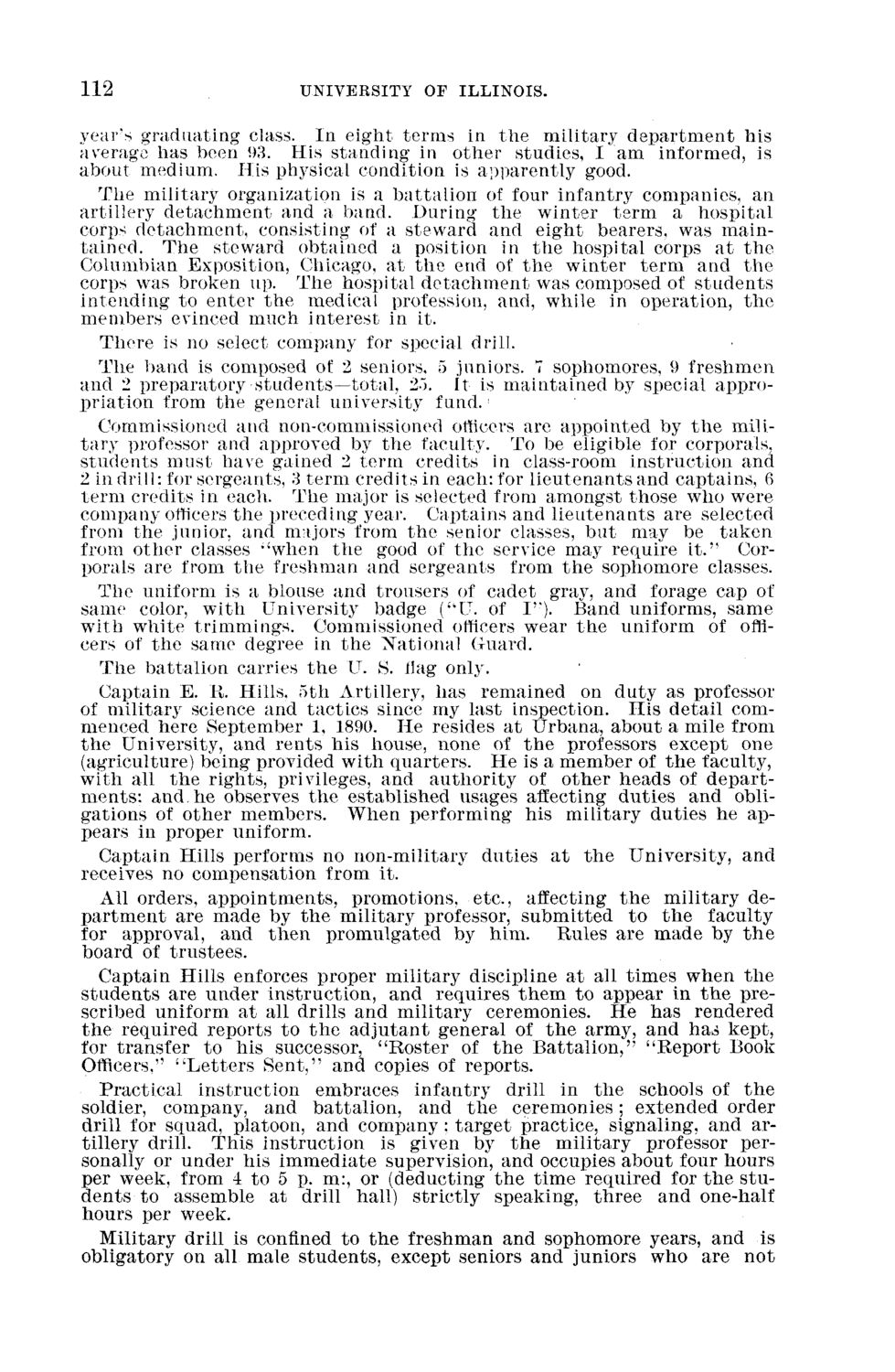| |
| |
Caption: Board of Trustees Minutes - 1894
This is a reduced-resolution page image for fast online browsing.

EXTRACTED TEXT FROM PAGE:
112 UNIVERSITY OF ILLINOIS. year's graduating class. In eight terms in the military department his average has been 93. His standing in other studies, I am informed, is about medium. His physical condition is apparently good. The military organization is a battalion of four infantry companies, an artillery detachment and a band. During the winter term a hospital corps detachment, consisting of a steward and eight bearers, was maintained. The steward obtained a position in the hospital corps at the Columbian Exposition, Chicago, at the end of the winter term and the corps was broken up. The hospital detachment was composed of students intending to enter the medical profession, and, while in operation, the members evinced much interest in it. There is no select company for special drill. The band is composed of 2 seniors, 5 juniors. 7 sophomores, 9 freshmen and 2 preparatory students—total, 2o. It is maintained by special appropriation from the general university fund. Commissioned and non-commissioned officers are appointed by t h e military professor and approved by the faculty. To be eligible for corporals, students must have gained 2 term credits in class-room instruction and 2 in drill: for sergeants, 3 term credits in each: for lieutenants and captains, 6 term credits in each. The major is selected from amongst those who were company officers the preceding year. Captains and lieutenants are selected from the junior, and majors from the senior classes, but may be taken from other classes "when the good of the service may require it." Corporals are from the freshman and sergeants from t h e sophomore classes. The uniform is a blouse and trousers of cadet gray, and forage cap of same color, with University badge ("U. of I'"). Band uniforms, same with white trimmings. Commissioned officers wear the uniform of officers of the same degree in the National Guard. The battalion carries the U. S. flag only. Captain E. R. Hills. 5th Artillery, has remained on duty as professor of military science and tactics since my last inspection. His detail commenced here September 1, 1890. He resides at Urbana, about a mile from the University, and rents his house, none of the professors except one (agriculture) being provided with quarters. He is a member of the faculty, with all the rights, privileges, and authority of other heads of departments; and, he observes the established usages affecting duties and obligations of other members. When performing his military duties he appears in proper uniform. Captain Hills performs no non-military duties at the University, and receives no compensation from it. All orders, appointments, promotions, etc., affecting t h e military department are made by the military professor, submitted to the faculty for approval, and then promulgated by him. Rules are made by t h e board of trustees. Captain Hills enforces proper military discipline at all times when the students are under instruction, and requires them to appear in the prescribed uniform at all drills and military ceremonies. He has rendered the required reports to t h e adjutant general of t h e army, and has kept, for transfer to his successor, "Roster of the Battalion," "Report Book Officers," "Letters Sent," and copies of reports. Practical instruction embraces infantry drill in the schools of t h e soldier, company, and battalion, and the ceremonies; extended order drill for squad, platoon, and company; target practice, signaling, and artillery drill. This instruction is given by the military professor personally or under his immediate supervision, and occupies about four hours per week, from 4 to 5 p. m:, or (deducting the time required for the students to assemble at drill hall) strictly speaking, three and one-half hours per week. Military drill is confined to the freshman and sophomore years, and is obligatory on all male students, except seniors and juniors who are not
| |